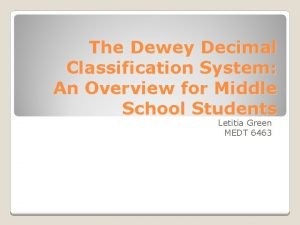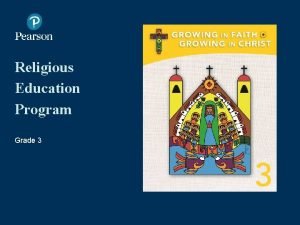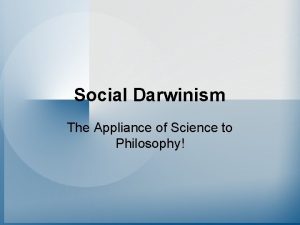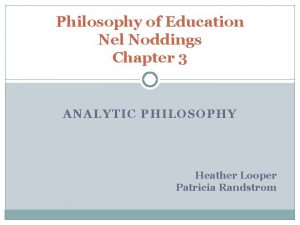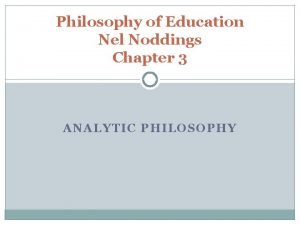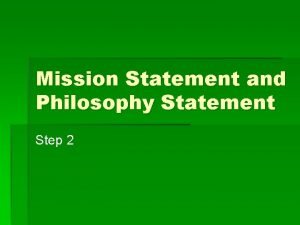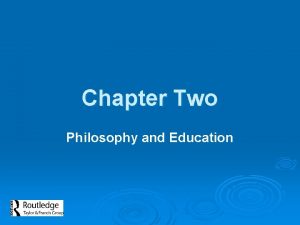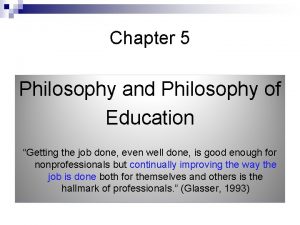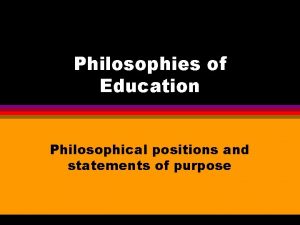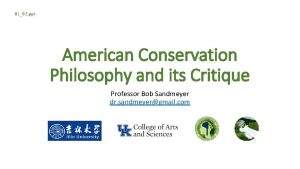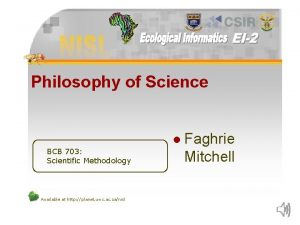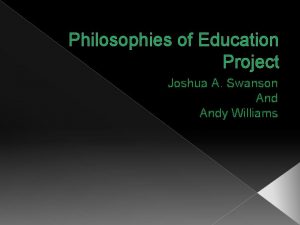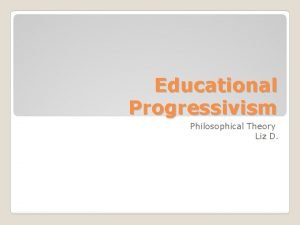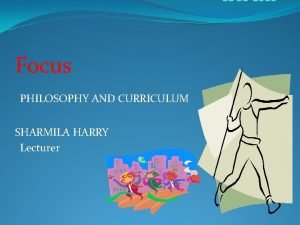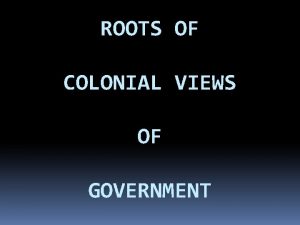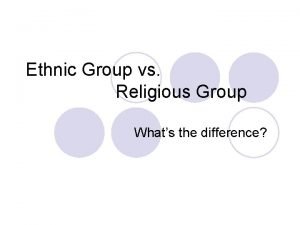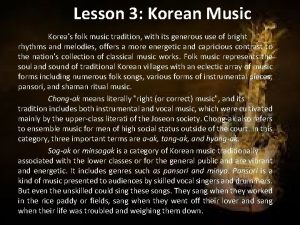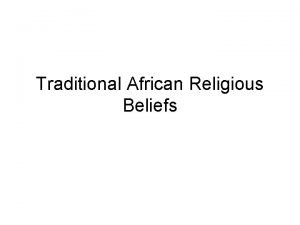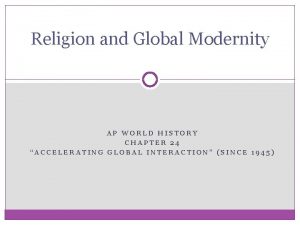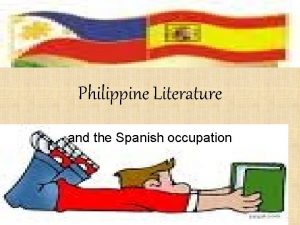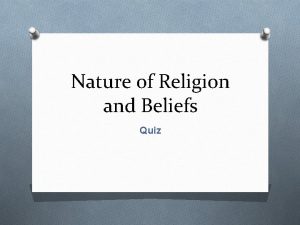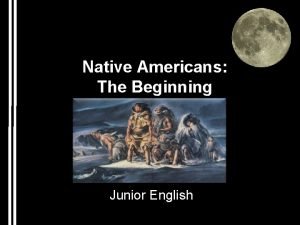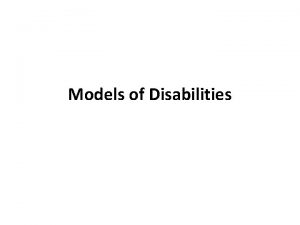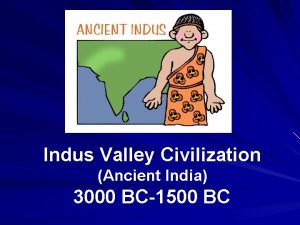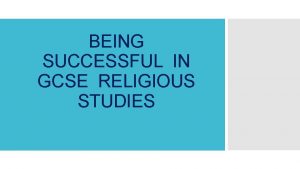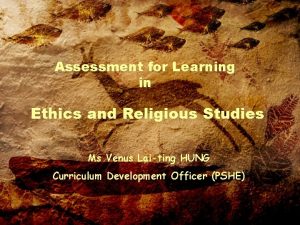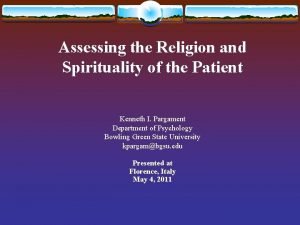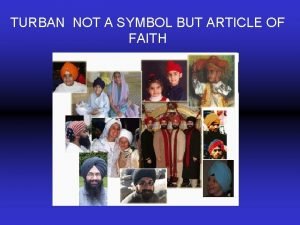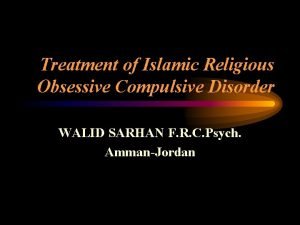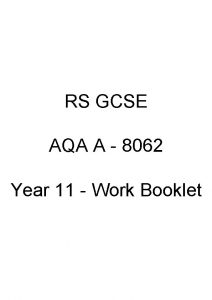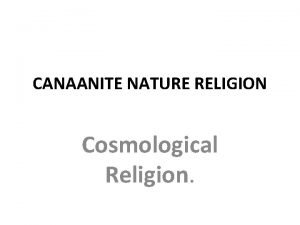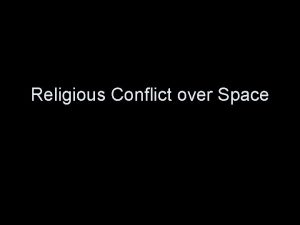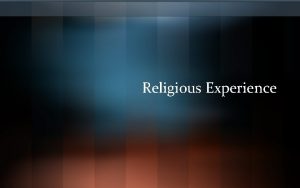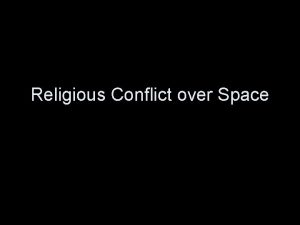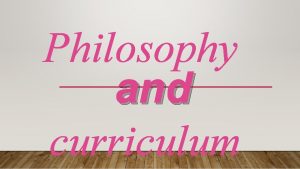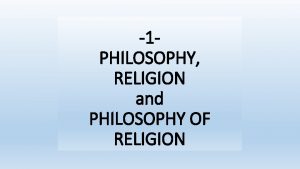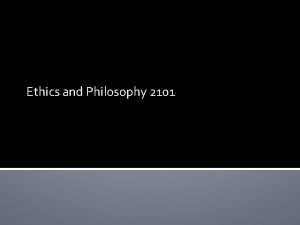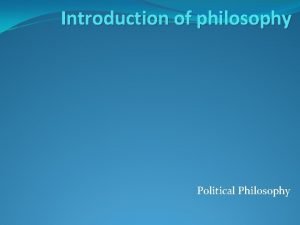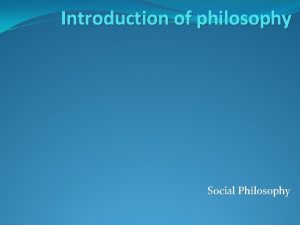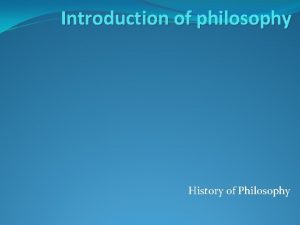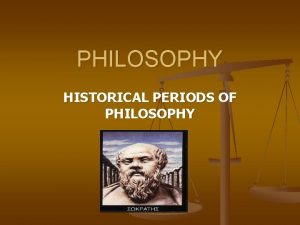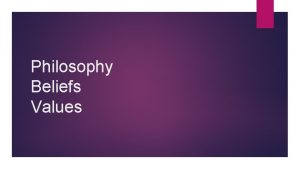Religious Education Year 9 Spring 1 Philosophy and







































































- Slides: 71

Religious Education Year 9 Spring 1 Philosophy and Ethics. Week 1 W/B Week 2 W/B Week 3 W/B Week 4 W/B Week 5 W/B Week 6 W/B 4 th January 11 TH January 18 th January 25 th January 1 st February 8 th February. Lesson 1 Lesson 2: Lesson 3 Lesson 4 Lesson 5 Lesson 6 Introduction to Ethics. Situation Ethics. Utilitarianism. Designer Babies. Humanism Design Argument. 1

LESSON 1 – Introduction to Ethics. Instructions: 1. Complete the DNA use online source to help you. Self-Asses on slide 4. 2. Watch the video Task and answer as many questions as you can on slide 6. 3. Write the definition of ethics in your book on slide 6 do the same for morality on slide 7. 4. Answer a series of ethical questions on slide 8 using reference to the terms. 5. Complete the PEEL paragraph and Self-Assess. 6. Review your learning on slide 11. 7. PLEASE NOTE: IF YOU DO NOT HAVE ACCESS TO THE INTERNET OR YOUR INTERNET IS DOWN, COMPLETE THE ‘CHECK YOUR UNDERSTANDNG’ QUESTIONS AT THE BOTTOM OF EACH INFORMATION SHEET FROM THE 2 TEXTBOOK.

DNA Questions (knowledge recap from previous lessons) 1. What are three persons of the Trinity? 2. What does Crucifixion and Resurrection mean? 3. Explain the story of the Nativity.

DNA ANSWERS Green Pen Reflection DNA Answers Questions (knowledge recap from previous lessons) 1. What are three persons of the Trinity? God the Father, God the Son, God the Holy Spirit 2. What does Crucifixion and Resurrection mean? Crucifixion – Remembers the death of Jesus dying on the cross. Resurrection: Remembers Jesus coming back alive 3 days after. 3. Explain the story of the Nativity. Mary was told by the Angel that she would have a Son and he would be the son of God. Mary would be a virgin. They were on way to Bethlehem when Jesus was born in a manger. They were visited by the magi (3 wise men) LO: To define what ethics and morality mean and how they impact on moral decision making. Key Words: Ethics, Morality, Philosophy, Moral Decision Making.

Video Task. Watch the video. Play along with the quiz and write your answers in your book. https: //www. youtube. com/watch? v=dzm. No. Fnxu 68 Write down what you think Ethics might mean. Provide an example. LO: To define what ethics and morality mean and how they impact on moral decision making. Key Words: Ethics, Morality, Philosophy, Moral Decision Making.

Green Pen Reflection What is ethics? Ethics refers to moral principles which govern the way we as humans behave in society. As humans, we are different, and we behave differently to others. LO: To define what ethics and morality mean and how they impact on moral decision making. Key Words: Ethics, Morality, Philosophy, Moral Decision Making.

Green pen Reflection What is morality? Morality refers to principles which concerns right and wrong or good and bad behaviour. LO: To define what ethics and morality mean and how they impact on moral decision making. Key Words: Ethics, Morality, Philosophy, Moral Decision Making.

Task. Read the questions and write what do you thin for each scenario. Make sure you refer to ethics and morality in your response. 1. If I do a good thing for a bad reason, does it matter? 2. Is it ok to do a bad thing for a good outcome? 3. Do the needs of many outweigh the needs of the few or the one? 4. Is what’s wrong for you necessarily wrong for me? 5. Does the rightness or wrongness of an action vary according to the situation? 6. Are we free to make moral choices? 7. Is being moral about following rules? 8. Should we use our heads or our hearts when deciding what’s right? Challenge: How can we 9. Can we have morals without religion? better justify our 10. Should I help my father before I help a stranger? argument? What 11. Is killing an unborn human as immoral as killing a born human? things can we do? 12. Should people who want to die be helped to die? LO: To define what ethics and morality mean and how they impact on moral decision making. Key Words: Ethics, Morality, Philosophy, Moral Decision Making.

PEEL Paragraph. Explain two reasons why Ethics are important. Success criteria: ü Explain fully using PEEL paragraphs ü Include a religious teaching and key words ü Include an example ü Give clear points which link to the question ü Link your paragraph back to the question P E E L One reason why ethics are important because… For example… (give an example of what he did) This means… (explain your point here) 10 minutes Two clear PEEL paragraph! Therefore, (link back to the question) LO: To define what ethics and morality mean and how they impact on moral decision making. Key Words: Ethics, Morality, Philosophy, Moral Decision Making.

Exemplar Ethics serve as a guide to moral daily living and helps us judge whether our behavior can be justified. Ethics refers to society's sense of the right way of living our daily lives. It does this by establishing rules, principles, and values on which we can base our conduct. Ethics refers to society’s sense of the right way of living our daily lives. It does this by establishing rules, principles, and values on which we can base our conduct. The concepts most directly associated with ethics are truth, honesty, fairness, and equity. Morals are a set of rules or mode of conduct on which society is based. Certain moral elements are universal, such as the laws forbidding homicide and the basic duties of doing good and furthering the well-being of others LO: To define what ethics and morality mean and how they impact on moral decision making. Key Words: Ethics, Morality, Philosophy, Moral Decision Making.

Review and Reflect One thing I have learnt from this lesson is… How does this link to what I already know? . . . One thing I found difficult from this lesson is… One question I have about this lesson is… One thing I would like support with is… 11

LESSON 2 – Situation Ethics. Instructions: 1. Complete the DNA on slide 16 and self-assess on slide 17. 2. Read the background information on slide 18 and using a highlighter, zoom in on any times, places and key words which link to Ethics. 3. Answer the ethical questions on slide 19. 4. Write the definition of Situation Ethics on slide 20. 5. Watch the entire video ‘Situation Ethics’ Type in the BBC link into a web browser. Complete the task on slide 21. Complete the Task set on slide 22. 6. Read the information on slide 23 -24 and pick one pro and one con and explain your opinion on it. Write the quote on slide 25 and explain what you think it means. 7. At the end, complete the PEEL paragraph on slide 26 and self-assess on slide 27. 8. Review your learning by answering the questions on slide 28. 9. PLEASE NOTE: IF YOU DO NOT HAVE ACCESS TO THE INTERNET OR YOUR INTERNET IS DOWN, COMPLETE THE ‘CHECK YOUR UNDERSTANDNG’ QUESTIONS AT THE BOTTOM OF EACH INFORMATION SHEET FROM THE TEXTBOOK. 12

DNA Questions (knowledge recap from previous lessons) 1. What does ethics mean? 2. What does morals mean? 3. Do these guide us to live our lives? Explain your answer. LO: To explain how Situation Ethics is used in the Bible. Key Words: Ethics, Situation Ethics, Agape, Parable, Good Samaritan.

DNA Answers DNA ANSWERS Green Pen Reflection Questions (knowledge recap from previous lessons) 1. What does ethics mean? Decisions people make on how to live a good life. 2. What does morals mean? Principles which govern your decisions eg: Religion, Culture. 3. Do these guide us to live our lives? Explain your answer. Opinion answer LO: To explain how Situation Ethics is used in the Bible. Key Words: Ethics, Situation Ethics, Agape, Parable, Good Samaritan.

Background Information What is Situation Ethics In situation ethics, right and wrong depend upon the situation. There are no universal moral rules or rights - each case is unique and deserves a unique solution. Situation ethics rejects 'prefabricated decisions and prescriptive rules'. It teaches that ethical decisions should follow flexible guidelines rather than absolute rules, and be taken on a case by case basis. Situation Ethics comes from a Christian approach where by love and agape are at the heart of all decisions. LO: To explain how Situation Ethics is used in the Bible. Key Words: Ethics, Situation Ethics, Agape, Parable, Good Samaritan.

1. Is moral behaviour about following rules or working things out for ourselves? 2. Are there unbreakable laws to govern moral behaviour, or should we make our own moral decisions? Task 3. Are there any situations when you should ignore established rules? LO: To explain how Situation Ethics is used in the Bible. Key Words: Ethics, Situation Ethics, Agape, Parable, Good Samaritan.

Self-Assess. What is Situation Ethics? Only one rule: follow the most loving course of action. This is known as the ‘Golden Rule’. It is a concept which comes from Christianity because the person who coined the term ‘situation ethics’ was a Christian (Joseph Fletcher). LO: To explain how Situation Ethics is used in the Bible. Key Words: Ethics, Situation Ethics, Agape, Parable, Good Samaritan.

Video Task Watch the video. Explain how does the Parable of the Good Samaritan shows Situation Ethic. I think the Parable of the Good Samaritan shows Situation Ethics… https: //www. youtube. com/watch? v=53 Pqw 20 x. K 10 LO: To explain how Situation Ethics is used in the Bible. Key Words: Ethics, Situation Ethics, Agape, Parable, Good Samaritan.

Reading Task - Choose two Bible stories from your worksheet. Situation Ethics: Only one rule: follow the most loving course of action. For each story you must: 1. Summaries the story 2. How is Situation Ethics shown in the story? 3. What do the stories teach us about the ‘Golden Rule’? LO: To explain how Situation Ethics is used in the Bible. Key Words: Ethics, Situation Ethics, Agape, Parable, Good Samaritan.

Self-Assess Strengths of Situation Ethics 1. Christian system – consistent with the teaching of Jesus. 2. It enables people to make tough decisions. 3. It emphasises love (agape) – surely everyone agrees that’s a good thing. 4. It avoids conflicts of duty as everyone is treated the same. 5. Where moral rules collide, Situation Ethics gives a way of resolving the conflict: love. LO: To explain how Situation Ethics is used in the Bible. Key Words: Ethics, Situation Ethics, Agape, Parable, Good Samaritan.

Self-Assess Weaknesses of Situation Ethics 1. Christian system – atheists and those of other faiths might not want to follow the example of Jesus. 2. It could allow for almost any action. 3. ‘Love’ is very subjective. 4. People naturally will disagree about what loving behaviour is. LO: To explain how Situation Ethics is used in the Bible. Key Words: Ethics, Situation Ethics, Agape, Parable, Good Samaritan.

Task. Situation Ethics in the Bible is very obvious: Write down one quote and explain in your own words what you think the quote means. "You must love the Lord your God with all your heart, and with all your soul, and with all your strength, and with all your mind; and you must love your neighbour as yourself. “ "God loves each of us as if there were only one of us. " LO: To explain how Situation Ethics is used in the Bible. Key Words: Ethics, Situation Ethics, Agape, Parable, Good Samaritan.

PEEL Paragraph. Explain two reasons why Situation Ethics are important. Success criteria: ü Explain fully using PEEL paragraphs ü Include a religious teaching and key words ü Include an example ü Give clear points which link to the question ü Link your paragraph back to the question P E E L One reason why Situation ethics are important because… For example… (give an example of what he did) This means… (explain your point here) 10 minutes Two clear PEEL paragraph! Therefore, (link back to the question) LO: To define what ethics and morality mean and how they impact on moral decision making. Key Words: Ethics, Morality, Philosophy, Moral Decision Making.

Exemplar In situation ethics, right and wrong depend upon the situation. There are no universal moral rules or rights - each case is unique and deserves a unique solution. Situation ethics rejects 'prefabricated decisions and prescriptive rules'. It teaches that ethical decisions should follow flexible guidelines rather than absolute rules, and be taken on a case by case basis. So a person who practices situation ethics approaches ethical problems with some general moral principles rather than a rigorous set of ethical laws and is prepared to give up even those principles if doing so will lead to a greater good. LO: To define what ethics and morality mean and how they impact on moral decision making. Key Words: Ethics, Morality, Philosophy, Moral Decision Making.

Review and Reflect One thing I have learnt from this lesson is… How does this link to what I already know? . . . One thing I found difficult from this lesson is… One question I have about this lesson is… One thing I would like support with is… 25

LESSON 3– Utilitarianism Instructions: 1. Complete the DNA and self-Assess on slide 34 2. Read the background information on slide 35 and using a highlighter, zoom in on and highlight any dates, times, places and key words which link to Utilitarianism. 3. Answer the questions on slide 36. Write the definition of Utilitarianism on slide 37. 4. Watch the video on slide 38 and complete the task on slide 38. 5. Read the feeding of the 5000 biblical story and complete the task set on slide 39. The story can be found on slide 46. 6. Complete the PEEL paragraph on slide 40 and self-Assess on slide 41. 7. At the end, complete the review task on slide 42. 8. PLEASE NOTE: IF YOU DO NOT HAVE ACCESS TO THE INTERNET OR YOUR INTERNET IS DOWN, COMPLETE THE ‘CHECK YOUR UNDERSTANDNG’ QUESTIONS AT THE BOTTOM OF EACH INFORMATION SHEET FROM THE TEXTBOOK. 26

DNA Questions (knowledge recap from previous lessons) 1. Explain what Situation Ethics means. 2. How is Situation Ethics shown in the Bible? 3. Is Situation Ethics an ideal approach to making moral decision? Explain your opinion.

DNA ANSWERS Green Pen Reflection DNA Answers Questions (knowledge recap from previous lessons) 1. Explain what Situation Ethics means. Solving ethical problems using the ‘most loving’ course of action. Known as ‘agape’ (unconditional love for humanity). 2. How is Situation Ethics shown in the Bible? Jesus forgiving the adulterer, The man who wouldn’t forgive, The parable of the Good Samaritan. 3. Is Situation Ethics an ideal approach to making moral decision? Explain your opinion here. LO: To explain how utilitarianism can be used to make moral decisions. Key Words: Utilitarianism, Principle of Utility, Morals, Ethics, Agape, Greatest Happiness.

Background Information Utilitarianism What does the greatest happiness for the greatest number actually mean? Is this something that we should consider? Will this make our world a better place full of happy people? This is what utilitarianism says. That any action we do, should think about consequences which have the greatest amount of happiness and pleasure for the greatest number of people. LO: To explain how utilitarianism can be used to make moral decisions. Key Words: Utilitarianism, Principle of Utility, Morals, Ethics, Agape, Greatest Happiness.

Task 1. A moral world is one in which many people as possible are happy as they can be? Do you agree. 2. When making a moral decision, is it more important to think about the action you are performing, or the consequence of that action? 3. “The good of the many outweighs the good of the few, or the one. ” Do you agree? LO: To explain how utilitarianism can be used to make moral decisions. Key Words: Utilitarianism, Principle of Utility, Morals, Ethics, Agape, Greatest Happiness.

Self-Assess Utilitarianism is an ethical theory behind the justification ‘for the greater good’. Theory focuses on the ‘greatest happiness for the greatest number of people’ LO: To explain how utilitarianism can be used to make moral decisions. Key Words: Utilitarianism, Principle of Utility, Morals, Ethics, Agape, Greatest Happiness.

Video Task Watch the video Task: Bullet point three more facts about utilitarianism. https: //www. youtube. com/watch? v=uvmz 5 E 75 ZIA LO: To explain how utilitarianism can be used to make moral decisions. Key Words: Utilitarianism, Principle of Utility, Morals, Ethics, Agape, Greatest Happiness.

Read the story of ‘The feeding of the 5000’ Task: 1. Read the story of the ‘Feeding of the 5000’ from the Bible. 2. Summaries the story in your own words. 3. Explain how utilitarianism is shown in the story. LO: To explain how utilitarianism can be used to make moral decisions. Key Words: Utilitarianism, Principle of Utility, Morals, Ethics, Agape, Greatest Happiness.

PEEL Paragraph. Explain one reason why utilitarianism is a good theory for moral decision making. Success criteria: ü Explain fully using PEEL paragraphs ü Include a religious teaching and key words ü Include an example ü Give clear points which link to the question ü Link your paragraph back to the question P E E L One way that utilitarianism is a good theory for moral decision making is because… For example… (give an example you can use to support your point) This means… (explain your point here) 10 minutes Therefore, (link back to the question) One clear PEEL paragraph! LO: To explain how utilitarianism can be used to make moral decisions. Key Words: Utilitarianism, Principle of Utility, Morals, Ethics, Agape, Greatest Happiness.

Exemplar In situation ethics, right and wrong depend upon the situation. There are no universal moral rules or rights - each case is unique and deserves a unique solution. Situation ethics rejects 'prefabricated decisions and prescriptive rules'. It teaches that ethical decisions should follow flexible guidelines rather than absolute rules, and be taken on a case by case basis. So a person who practices situation ethics approaches ethical problems with some general moral principles rather than a rigorous set of ethical laws and is prepared to give up even those principles if doing so will lead to a greater good. LO: To define what ethics and morality mean and how they impact on moral decision making. Key Words: Ethics, Morality, Philosophy, Moral Decision Making.

Review and Reflect One thing I have learnt from this lesson is… How does this link to what I already know? . . . One thing I found difficult from this lesson is… One question I have about this lesson is… One thing I would like support with is… 36


LESSON 4 – Designer Baby Instructions: 1. Complete the DNA task on slide 48 and self-assess slide 49. 2. Read the background information on slide 50 and using a highlighter, zoom in on and highlight any times, places and key words which link to designer babies. 3. Watch the entire video ‘Designer baby’ Type in the BBC link into a web browser. Complete the task on slide 52. 4. Read the information on slide 53 and answer the opinion question on slide 53. 5. At the end, complete the PEEL Paragraph on slide 54 and self-assess on slide 55 6. Review your learning by answering the questions on slide 56. 7. PLEASE NOTE: IF YOU DO NOT HAVE ACCESS TO THE INTERNET OR YOUR INTERNET IS DOWN, COMPLETE THE ‘CHECK YOUR UNDERSTANDNG’ QUESTIONS AT THE BOTTOM OF EACH INFORMATION SHEET FROM THE TEXTBOOK. 38

DNA Questions (knowledge recap from previous lessons) 1. What is Utilitarianism? 2. Give one example of how Utilitarianism is shown in the Bible. 3. Is Utilitarianism an ideal approach to making moral decision? Explain your opinion.

DNA ANSWERS Green Pen Reflection DNA Answers Questions (knowledge recap from previous lessons) 1. What is Utilitarianism? An ethical theory which seeks to create the greatest happiness for the greatest number of people. 2. Give one example of how Utilitarianism is shown in the Bible. The Feeding of the 5000. 3. Is Utilitarianism an ideal approach to making moral decision? Explain your opinion. Be prepared to share. LO: To evaluate whether designer babies are ethical. Key Words: Ethics, Morality, Designer Baby, Embryo, Gene.

Background Information Designer Babies: Designer babies - procedures that mostly involve checking embryos for disease, disorder or gender. It may be possible in the future to select for other qualities such as strength, beauty or intelligence. Procedures include: • In Vitro Fertilisation (IVF) happens outside the body, e. g. used when the parents are experiencing fertility problems or when a genetic disorder might be passed on by the parents. • Pre-Implantation Genetic Diagnosis (PGD) involves screening embryos at around three days old to check for genetic disorders, e. g. cystic fibrosis. PGD can also be used to check embryos to see if any will be a genetic match for a sibling who is already sick. • Pre-Implantation Genetic Screening (PGS) involves screening embryos to identify gender. In the UK, this is only legal when used for medical reasons, e. g. with risk of a child inheriting a gender linked disease, e. g. Duchenne muscular dystrophy. Designer babies is a huge ethical problem amongst many people in the UK and largely goes against religious beliefs also. LO: To evaluate whether designer babies are ethical. Key Words: Ethics, Morality, Designer Baby, Embryo, Gene.

Write the definition LO: To evaluate whether designer babies are ethical. Key Words: Ethics, Morality, Designer Baby, Embryo, Gene.

Video Task. Watch the video Task: Write down 5 or more facts. https: //www. youtube. com/watch? v=2 TLs. YJkl. M-8 LO: To evaluate whether designer babies are ethical. Key Words: Ethics, Morality, Designer Baby, Embryo, Gene.

Task. An area for debate is what genetic disorders can a baby be tested for during pregnancy. Pregnant women are routinely offered screening for genetic disorders such as Down's syndrome, but there is concern about the growing number of tests. Last year doctors aborted a foetus beyond 24 weeks' gestation because the mother, taking advice from doctors, did not want a baby with a cleft palate. A cleft palate is not life threatening and usually is only a cosmetic concern. So should a foetus be aborted because they may look slightly different from other children even though they are healthy? Or are we saving the child from the torment of bullying due to its differing looks? LO: To evaluate whether designer babies are ethical. Key Words: Ethics, Morality, Designer Baby, Embryo, Gene.

PEEL Paragraph. Explain your opinion on whether a person should be able to design their own baby. Success criteria: ü Explain fully using PEEL paragraphs ü Include a religious teaching and key words ü Include an example ü Give clear points which link to the question ü Link your paragraph back to the question P E E L One reason why a person should/should not be able to design their own baby is… For example… (give an example of what he did) This means… (explain your point here) 10 minutes Two clear PEEL paragraph! Therefore, (link back to the question) LO: To define what ethics and morality mean and how they impact on moral decision making. Key Words: Ethics, Morality, Philosophy, Moral Decision Making.

Exemplar It is morally unacceptable to design your own baby as you are playing God. Most religious believers would oppose this idea and ethical philosophies would too. For example, Any ethical debate “will also naturally run against practicalities like funding”, says The Independent. Many patients are subject already to a postcode lottery in accessing fertility treatment based on their local NHS funding, and “gene editing could initially be out of reach for all but the richest”, adds the newspaper. Acknowledging this problem, panel chair Professor Yeung said that if funding inequalities “were to exacerbate social injustice, in our view that would not be an ethical approach”. LO: To define what ethics and morality mean and how they impact on moral decision making. Key Words: Ethics, Morality, Philosophy, Moral Decision Making.

Review and Reflect One thing I have learnt from this lesson is… How does this link to what I already know? . . . One thing I found difficult from this lesson is… One question I have about this lesson is… One thing I would like support with is… 47

LESSON 5 – Humanism. Instructions: 1. Complete the DNA on slide 61 and self-assess on slide 62. 2. Read the background information on slide 63 and highlight key points on humanism including the meaning of it. 3. Complete the video Task on slide 64. Self-Assess on slide 65. 4. Complete the video task on slide 66 and answer the questions on slide 67. 5. At the end, complete the Written Task on slide 68. 6. Self-Assess on slide 69 and review your learning on slide 70. 7. PLEASE NOTE: IF YOU DO NOT HAVE ACCESS TO THE INTERNET OR YOUR INTERNET IS DOWN, COMPLETE THE ‘CHECK YOUR UNDERSTANDNG’ QUESTIONS AT THE BOTTOM OF EACH INFORMATION SHEET FROM THE 48 TEXTBOOK.

DNA Questions (knowledge recap from previous lessons) 1. What is a designer baby? 2. Explain religious views about designer babies. 3. Are designer babies ethical? Explain your opinion.

DNA Answers DNA ANSWERS Green Pen Reflection Questions (knowledge recap from previous lessons) 1. What is a designer baby? Genetic makeup of the baby has been altered to eradicate genes or defects. 2. Explain religious views about designer babies. Most religions argue that it is wrong as it is almost like playing God. 3. Are designer babies ethical? Explain your opinion – be prepared to share your answer. LO: To evaluate whether Humanism is an effective approach to moral decision making. Key Words: Ethics, Morality, Humanism, Utilitarianism, Situation Ethics.

Background Information Humanism: Throughout recorded history there have been non-religious people who have believed that this life is the only life we have, that the universe is a natural phenomenon with no supernatural side, and that we can live ethical and fulfilling lives on the basis of reason and humanity. They have trusted to the scientific method, evidence, and reason to discover truths about the universe and have placed human welfare and happiness at the centre of their ethical decision making. Today, people who share these beliefs and values are called humanists and this combination of attitudes is called Humanism. Many millions of people in the UK share this way of living and of looking at the world, but many of them have not heard the word ‘humanist’ and don’t realise that it describes what they believe. LO: To evaluate whether Humanism is an effective approach to moral decision making. Key Words: Ethics, Morality, Humanism, Utilitarianism, Situation Ethics.

Video Task. Watch the video: What do you think Humanism is? https: //www. youtube. com/watch? v=3 j 8 j. Qk. Sydeo LO: To evaluate whether Humanism is an effective approach to moral decision making. Key Words: Ethics, Morality, Humanism, Utilitarianism, Situation Ethics.

Self-Assess What is Humanism? No superstition or belief in God. You are in charge of the world around you and your own life. People decide what is right and moral not God. LO: To evaluate whether Humanism is an effective approach to moral decision making. Key Words: Ethics, Morality, Humanism, Utilitarianism, Situation Ethics.

Task Watch the 4 mini-animations narrated by Stephen Fry. Task: Summaries what each video is about. You will be given 2 minutes to write after every video. https: //humanism. org. uk/thatshumanism/ LO: To evaluate whether Humanism is an effective approach to moral decision making. Key Words: Ethics, Morality, Humanism, Utilitarianism, Situation Ethics.

Probing questions: 1. What do you think about Humanism? • You said that. . . have you considered. . . ? • Why do you think that? • What evidence do you have for. . . ? Task. 2. It is a good thing? 3. Does it give people more ownership, control and responsibility? 4. Does having no belief in God change perspective? 5. Why might this be a problem for some people? • What flaws are there in your argument? • How might somebody who. . . respond to the point that. . . ? • How would you defend. . . ? Habits of great discussion: • Positive body language (e. g. face the person you’re talking to, make eye contact). • Provide full sentence, developed responses. LO: To evaluate whether Humanism is an effective approach to moral decision making. Key Words: Ethics, Morality, Humanism, Utilitarianism, Situation Ethics.

Writing Task. Explain the advantages and disadvantages of using Humanism as a purpose for moral decision making (5 marks) Firstly, the advantages of using Humanism for moral decision making are… (explain 2 advantages). On the other hand, the disadvantages of using Humanism for moral decision making are… (explain 2 disadvantages). Give an example of a moral decision in your answers. LO: To evaluate whether Humanism is an effective approach to moral decision making. Key Words: Ethics, Morality, Humanism, Utilitarianism, Situation Ethics.

Self-Assess LO: To define what ethics and morality mean and how they impact on moral decision making. Key Words: Ethics, Morality, Philosophy, Moral Decision Making.

Review and Reflect One thing I have learnt from this lesson is… How does this link to what I already know? . . . One thing I found difficult from this lesson is… One question I have about this lesson is… One thing I would like support with is… 58

LESSON 6 – Design Argument. Instructions: 1. Complete the DNA task on slide 75 and self-asses on slide 76. 2. Complete the background information on slide 77 and highlight key points on what the design argument is. 3. Watch the video on slide 78 and complete the task on slide 78. 4. Complete the Task on slide 79 and complete the problem Task on slide 80. Using slide 81 -82. 5. Complete PEEL paragraph on slide 83 and self-assess on slide 84. 6. Review your learning by answering the questions on slide 85. 7. PLEASE NOTE: IF YOU DO NOT HAVE ACCESS TO THE INTERNET OR YOUR INTERNET IS DOWN, COMPLETE THE ‘CHECK YOUR UNDERSTANDNG’ QUESTIONS AT THE BOTTOM OF EACH INFORMATION SHEET FROM THE TEXTBOOK. 59

DNA Questions (knowledge recap from previous lessons) 1. What do Humanists believe about life? 2. Explain how Humanists respond to moral and ethical dilemmas? 3. Summaries what Stephen Fry says about Science and Religion. LO: To explain William Paley’s watch making theory. Key Words: Philosophy, Design Argument, Teleological Argument, William Paley.

DNA ANSWERS Green Pen Reflection DNA Answers Questions (knowledge recap from previous lessons) 1. What do Humanists believe about life? They do not believe in God, they believe that you only have one life and there is no afterlife. Live life to its potential. 2. Explain how Humanists respond to moral and ethical dilemmas? They argue that moral and ethical dilemmas should me solved by people using rational decision making. 3. Summaries what Stephen Fry says about Science and Religion is superstitious and science uses facts to prove existence of everything. LO: To explain William Paley’s watch making theory. Key Words: Philosophy, Design Argument, Teleological Argument, William Paley.

Background Information Teleology stems from the Greek word ‘telos’ meaning ‘end’ or ‘purpose’. It is used in philosophy as an argument for the existence of God to suggest that their is order and a purpose to the world. The teleological argument is also known as the design argument. It is based on observation of the apparent order, design and purpose in the universe and the natural world to conclude that it is not the result of mere chance, but of design. E. g. Changing seasons, intricate human body, life style of animals. The evidence from design points to a designer and the argument concludes that the designer is God. LO: To explain William Paley’s watch making theory. Key Words: Philosophy, Design Argument, Teleological Argument, William Paley.

Video Ta Watch the video: https: //www. youtube. com/watch? v=tno. QZA 8 MA 6 A Write down what William Paley’s argument is about. LO: To explain William Paley’s watch making theory. Key Words: Philosophy, Design Argument, Teleological Argument, William Paley.

Task Read William Paley’s watch theory. Summaries theory in your book and answer the questions from the worksheet. LO: To explain William Paley’s watch making theory. Key Words: Philosophy, Design Argument, Teleological Argument, William Paley.

Task. What problems might there be with Paley’s watch theory? LO: To explain William Paley’s watch making theory. Key Words: Philosophy, Design Argument, Teleological Argument, William Paley.

Self-Assess 1 Richard Dawkins argues the universe could have been generated by very small, randomly generated steps. Just because we’re purposedriven, doesn’t mean the universe is. LO: To explain William Paley’s watch making theory. Key Words: Philosophy, Design Argument, Teleological Argument, William Paley.

Self-Assess 2 David Hume was highly critical of analogical arguments. Using a watch (that we know about) to explain the universe (that we don’t know about) is DAFT. We can’t apply an analogy about something limited and imperfect to something unlimited and perfect LO: To explain William Paley’s watch making theory. Key Words: Philosophy, Design Argument, Teleological Argument, William Paley.

You do William Paley’s watching making theory is a good theory to explain the creation of the world and existence of God. Success criteria: ü Explain fully using PEEL paragraphs ü Include a religious teaching and key words ü Include an example ü Give clear points which link to the question ü Link your paragraph back to the question P E E L This is a good theory because… For example… (give an example you can use to support your point) This means… (explain your point here) 10 minutes Therefore, (link back to the question) One clear PEEL paragraph! LO: To explain William Paley’s watch making theory. Key Words: Philosophy, Design Argument, Teleological Argument, William Paley.

Exemplar It is morally unacceptable to design your own baby as you are playing God. Most religious believers would oppose this idea and ethical philosophies would too. For example, Any ethical debate “will also naturally run against practicalities like funding”, says The Independent. Many patients are subject already to a postcode lottery in accessing fertility treatment based on their local NHS funding, and “gene editing could initially be out of reach for all but the richest”, adds the newspaper. Acknowledging this problem, panel chair Professor Yeung said that if funding inequalities “were to exacerbate social injustice, in our view that would not be an ethical approach”. LO: To define what ethics and morality mean and how they impact on moral decision making. Key Words: Ethics, Morality, Philosophy, Moral Decision Making.

Review and Reflect One thing I have learnt from this lesson is… How does this link to what I already know? . . . One thing I found difficult from this lesson is… One question I have about this lesson is… One thing I would like support with is… 70

FOR THE EXISTENCE OF GOD The original argument from design (teleological) was by Saint Thomas Aquinas way back in 1224! The best example is probably by William Paley (1743 -1805) who also argued that God exists by looking at the design of the Universe. He said, imagine finding a watch in the street, if you had never seen one before, on examining it, you would see the workings are very complicated and there must have been a watchmaker who designed and put it together. It hasn’t happened just by chance. He then said, it’s the same when you look at the world. It have been made by chance. It is so complicated yet fits perfectly into place, someone had to design and make it one was God. The world looks like it was designed DNA etc Life is too complex and too special to be an accident of nature These are three logical reasons for believing in God could not everything and that some CHARLES DARWIN - THEORY OF EVOLUTION Everything in life has a cause. Life itself must have been caused ……by God. Darwin’s theory was that life evolved from simple structures, through a process of natural selection to create the complex world that we live in. It had nothing to do with God being the designer. Religious believers countered this view by saying that God started the process of evolution and knew what was going to happen and therefore was still the designer. IN YOUR BOOK 1. Write the title ‘The Argument From Design For The Existence of God. 2. Draw a basic outline of the cross and write in the three logical reasons for believing in God, as it is shown above. 3. Who was the first person to explain the argument by design? State in your own words how William Paley explained the design theory. 4. Why was Darwin’s theory of evolution a problem to a believer in the design theory? 5. How ( in two words) do scientists explain the origin of life & the Universe? 6. Imagine you are trying to persuade someone that the world was designed and so there must be a designer. Write as many different reasons as you can think of (a, b, c, etc) to support your argument.
 Religious philosophy
Religious philosophy Four seasons korean movie
Four seasons korean movie Which months are spring
Which months are spring Hellenic ministry of education and religious affairs
Hellenic ministry of education and religious affairs Grade 3 religion book
Grade 3 religion book History and philosophy of environmental education
History and philosophy of environmental education Tiny feet poem
Tiny feet poem Philosophy of herbert spencer in education
Philosophy of herbert spencer in education Analytic philosophy in education
Analytic philosophy in education Noddings philosophy of education
Noddings philosophy of education State 4 philosophies of extension education
State 4 philosophies of extension education Physical education mission statement examples
Physical education mission statement examples 3 branches of philosophy
3 branches of philosophy Branches of philosophy
Branches of philosophy Education in sparta and athens
Education in sparta and athens Philosophy of education nel noddings
Philosophy of education nel noddings Hindu philosophy of education
Hindu philosophy of education Teaching philosophy
Teaching philosophy Allama iqbl
Allama iqbl Physical education philosophy statements
Physical education philosophy statements Social reconstructionists believe that
Social reconstructionists believe that Realism philosophy in education
Realism philosophy in education Perennialism in education
Perennialism in education Ant philosophy ppt
Ant philosophy ppt Paragraph writing rabindranath tagore
Paragraph writing rabindranath tagore Scientific method francis bacon
Scientific method francis bacon What is perennialism in philosophy of education
What is perennialism in philosophy of education Logo
Logo Philosophy of education in japan
Philosophy of education in japan What is progressivism philosophy
What is progressivism philosophy Perennialism philosophy of education
Perennialism philosophy of education What is progressivism philosophy
What is progressivism philosophy Perenialist
Perenialist Mtep malaysia
Mtep malaysia Https spring edval education
Https spring edval education Religious symbolism in the old man and the sea
Religious symbolism in the old man and the sea Religious and classical roots explanation
Religious and classical roots explanation Cognitive and non cognitive religious language
Cognitive and non cognitive religious language Religious imagery in romeo and juliet
Religious imagery in romeo and juliet Public affairs and religious liberty
Public affairs and religious liberty Whats ethnic group
Whats ethnic group Used in both the folk and classical music of korea
Used in both the folk and classical music of korea How are ethnic groups and religious groups related
How are ethnic groups and religious groups related Greek and roman art similarities
Greek and roman art similarities How formal education differ from als
How formal education differ from als Differentiate between health education and health promotion
Differentiate between health education and health promotion Fervor
Fervor Religious institutions
Religious institutions Religious organisation
Religious organisation Religious fundamentalism ap world history
Religious fundamentalism ap world history Awit in philippine literature
Awit in philippine literature Question for religion
Question for religion Native american religious beliefs
Native american religious beliefs The moral/religious model example
The moral/religious model example Religious allegory in lord of the flies
Religious allegory in lord of the flies The aryan caste system
The aryan caste system Hypocrite origin
Hypocrite origin Re past papers eduqas
Re past papers eduqas Religious studies assessment
Religious studies assessment Spiritual v religious
Spiritual v religious Religious archives examples
Religious archives examples Aqa religious studies gcse 2020 paper
Aqa religious studies gcse 2020 paper Ancient religious art
Ancient religious art Eduqas religious studies a level past papers
Eduqas religious studies a level past papers Bricked alive
Bricked alive Religious ocd islam
Religious ocd islam Aqa 8062
Aqa 8062 Mco1700.23f
Mco1700.23f Religious discrimination
Religious discrimination Tolkiens elves
Tolkiens elves Identify seven characteristics of the canaanite religion
Identify seven characteristics of the canaanite religion Religious beliefs about helping victims of war
Religious beliefs about helping victims of war
